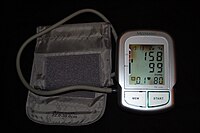
Photo from wikipedia
AIMS To evaluate the association between flash glucose monitoring (FLASH) frequency and glycemic parameters during real-life circumstances in the Netherlands. METHODS Obtained glucose readings were de-identified and uploaded to a… Click to show full abstract
AIMS To evaluate the association between flash glucose monitoring (FLASH) frequency and glycemic parameters during real-life circumstances in the Netherlands. METHODS Obtained glucose readings were de-identified and uploaded to a dedicated database when FLASH reading devices were connected to internet. Data between September 2014 and March 2020, comprising 16,331 analyzable readers (163,762 sensors) were analyzed. Scan rate per reader was determined and each reader was sorted into 20 equally sized rank ordered groups (n=817 each). RESULTS Users performed a median of 11.5 [IQR 7.7-16.7] scans per day. Those in the lowest and highest ventiles scanned on average 3.7 and 40.0 times per day and had an eHbA1c of 8.6% (71 mmol/mol) and 6.9% (52 mmol/mol), respectively. Increasing scan rates were associated with more time in target range (3.9-10 mmol/L), less time in hyperglycemia (>10 mmol/L), and a lower standard deviation of glucose. An eHbA1c of 7.0% (53 mmol/mol) translated in approximately 65% time in target range, 30% time in hyperglycemia and 5% time in hypoglycemia (<3.9 mmol/L). CONCLUSIONS These outcomes among Dutch FLASH users suggest that with higher scan rate glycemic control improves.
Journal Title: Diabetes research and clinical practice
Year Published: 2021
Link to full text (if available)
Share on Social Media: Sign Up to like & get
recommendations!